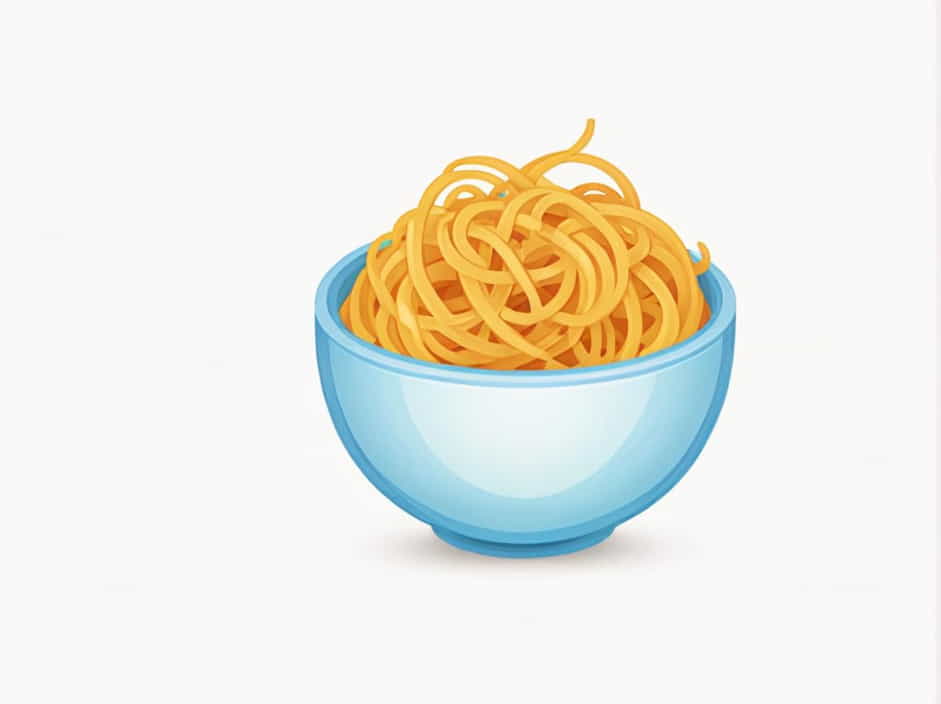Vermicelli is a type of pasta known for its thin, noodle-like shape. It is popular in various cuisines worldwide, used in both savory and sweet dishes. Though it resembles spaghetti, vermicelli is typically thinner and can be made from different types of flour, including wheat and rice.
This topic explores the meaning of vermicelli, its origin, types, culinary uses, and nutritional benefits.
What Does “Vermicelli” Mean?
The word “vermicelli” comes from the Italian language, meaning “little worms” due to its thin and elongated shape. It is a type of pasta that varies in thickness depending on the country and cuisine.
Origin of Vermicelli
- The term has been used in Italy since the 14th century to describe fine, thin pasta.
- In Asia, a similar form of thin noodles has been used for centuries, especially in Chinese, Indian, and Thai cuisine.
Common Characteristics of Vermicelli
- Thin, long, and cylindrical shape.
- Made from different types of flour (wheat, rice, or semolina).
- Used in various cuisines for soups, stir-fries, and desserts.
Types of Vermicelli
Vermicelli is categorized based on ingredients and regional variations.
1. Italian Vermicelli
- Made from durum wheat.
- Slightly thicker than Asian vermicelli.
- Commonly used in pasta dishes like carbonara and tomato-based sauces.
2. Rice Vermicelli
- Made from rice flour.
- Thin and translucent when cooked.
- Popular in Asian cuisine, used in stir-fries and soups.
3. Semolina Vermicelli
- Made from semolina wheat flour.
- Common in Indian and Middle Eastern cuisine.
- Often used in sweet and savory dishes.
4. Cellophane Vermicelli (Glass Noodles)
- Made from mung bean starch.
- Becomes transparent when cooked.
- Used in spring rolls, stir-fries, and soups.
How Vermicelli Is Used in Different Cuisines
Vermicelli is a versatile ingredient found in various global cuisines.
1. Italian Cuisine
- Often used in light pasta dishes.
- Paired with olive oil, garlic, and seafood.
2. Indian Cuisine
- Used in savory dishes like “Upma” (spiced vermicelli with vegetables).
- Used in sweet dishes like “Seviyan Kheer” (sweet milk pudding).
3. Chinese and Thai Cuisine
- Common in stir-fried noodle dishes.
- Used in soups and spring rolls.
4. Middle Eastern Cuisine
- Added to rice dishes for extra texture.
- Used in desserts like Kunafa (a layered pastry with vermicelli and cheese).
Nutritional Value of Vermicelli
Vermicelli’s nutritional content depends on the type of flour used.
General Nutritional Facts (per 100g cooked vermicelli)
- Calories: ~150 kcal
- Carbohydrates: ~30g
- Protein: ~3g
- Fat: ~0.5g
- Fiber: ~1g
Health Benefits of Vermicelli
✔ Energy Source – High in carbohydrates, providing instant energy.
✔ Low in Fat – Suitable for low-fat diets.
✔ Easy to Digest – Especially rice vermicelli, which is gluten-free.
Possible Drawbacks
✖ High in Carbohydrates – Not ideal for low-carb diets.
✖ Low in Fiber and Protein – Needs to be paired with vegetables and protein sources for a balanced meal.
How to Cook Vermicelli
Vermicelli is quick and easy to cook.
Basic Cooking Steps
- Boil water with a pinch of salt.
- Add vermicelli and cook for 2-4 minutes (depending on the type).
- Drain and rinse with cold water to prevent sticking.
- Use in your desired recipe.
Popular Vermicelli Dishes
- Vermicelli Soup – A comforting dish with broth and vegetables.
- Vermicelli Stir-Fry – Mixed with soy sauce, meat, and vegetables.
- Sweet Vermicelli Pudding – Made with milk, sugar, and nuts.
Vermicelli vs. Other Noodles
| Feature | Vermicelli | Spaghetti | Rice Noodles | Glass Noodles |
|---|---|---|---|---|
| Thickness | Thin | Thicker | Very thin | Thin and transparent |
| Main Ingredient | Wheat/Rice | Wheat | Rice | Mung bean starch |
| Common Use | Soups, stir-fries, desserts | Pasta dishes | Asian dishes | Spring rolls, soups |
| Cooking Time | 2-4 mins | 8-12 mins | 2-3 mins | 3-5 mins |
Storing Vermicelli
Vermicelli has a long shelf life when stored properly.
Storage Tips
- Uncooked Vermicelli – Keep in an airtight container in a cool, dry place.
- Cooked Vermicelli – Store in the refrigerator and use within 2-3 days.
Vermicelli is a thin, versatile noodle used in many cuisines around the world. Whether in pasta dishes, stir-fries, soups, or desserts, it adds flavor and texture to meals. With various types such as wheat, rice, and glass noodles, vermicelli is a staple in many cultures. Understanding its uses, nutritional value, and cooking methods can help you make the most of this delicious ingredient.
